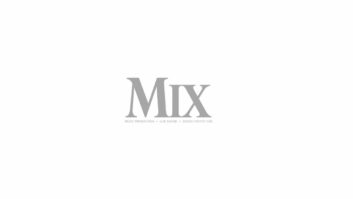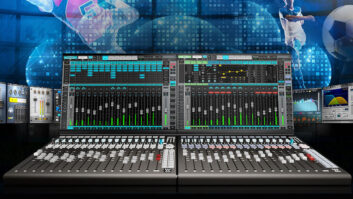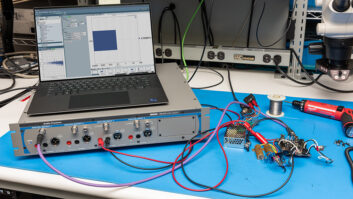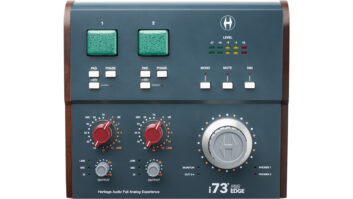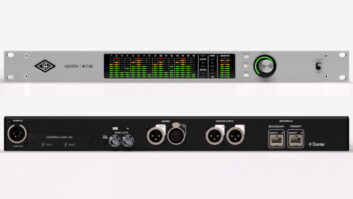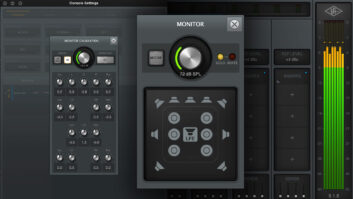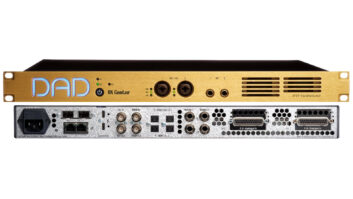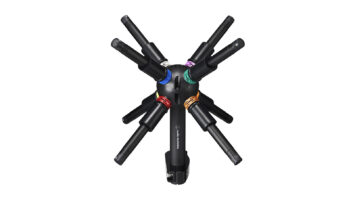by Frank Wells.
After the invention of the transistor in 1947, semiconductors began rapidly supplanting the electron tube for all but the most specialized uses (yes, like in some of your favorite analog gear). Today’s high-powered computing ICs incorporate transistor counts besting a million per square millimeter. Individual transistors and their integrated circuit brethren form the building blocks of most of today’s audio devices, be they analog or digital, simple amplifier stages or processing blocks.
Each year, Pro Sound News queries audio design engineers about their semiconductor usage. This year’s respondents are B.J. Buchalter, VP R&D at Metric Halo; David Eltzroth, President and CEO of ROX Electronics; Tony Gambacurta, Sr. Engineer at Whirlwind Music Distributors; Director of Product Strategy for Focusrite, Rob Jenkins; Patrick Quilter, Senior Audio Designer at QSC Audio Products; David Thibodeau, VP at Daking Audio; and Tonelux Designs President, Paul Wolff.
An abridged version of their replies ran in the March, 2010 issue of Pro Sound News; the unabridged replies follow. Where there’s no reply for a given respondent, the question was either considered not applicable, or, in some cases, the answer would have given away future plans for new products (one respondent requesting we get back to him next year when he’ll tell us what all his company’s new products have inside).
ANALOG
1. Analog components, general:
a) For analog design, have you discovered any new chips recently?
ROX Electronics—David Eltzroth: Yes, The new chip sets offered by THAT Corporation. The 1200 ingenious, 1646 line driver and 4301 VCA Solution.
QSC Audio—Patrick Quilter: Yes.
Metric Halo—B.J. Buchalter: THAT-1570/THAT-1571.
Daking Audio—Dave Thibodeau: The THAT Corp Digital Pre amp controller. 5171.
Tonelux Designs—Paul Wolff: Yes, I am good friends with Mike Centorino at TI, he just sent me a new dual chip [op amp] that sounds great and has really low noise. It’s an OPA 1642.
Whirlwind—Tony Gambacurta: THAT 1570, 1510, 4315, TI OPA2211, TI TLC2272.
b) Are you using different components than you have traditionally?
ROX Electronics—David Eltzroth: Besides new chips sets not really.
QSC Audio—Patrick Quilter: Yes.
Metric Halo—B.J. Buchalter: Not really, although the components of the types that we have been using continue to evolve and we continually evaluate new products to see if they fit with upgrades or new designs.
Daking Audio—Dave Thibodeau: No.
Tonelux Designs—Paul Wolff: Most of me designs are discrete, using the Tonelux TX-240 op-amp, but there are situations where a monolithic chip works just fine.
Whirlwind—Tony Gambacurta: More ICs, Less discrete. This is true both in high performance, as well as low cost.
c) If so, what are they and in what areas are you seeing improvement (ease of design, performance aspects, etc).
ROX Electronics—David Eltzroth: We have seen a big improvement in sonic and lower noise performance as well as stability from the new generation of IC chips offered by THAT Corp.
QSC Audio—Patrick Quilter: Class D enabling devices – gate drivers, PFC controllers, and some fun with effects chips in a side project.
Metric Halo—B.J. Buchalter: Generally in terms of noise and distortion specifications. Unfortunately, this is always in competition with quiescent power, which is a real issue for the sorts of high-density designs we do.
Tonelux Designs—Paul Wolff: I will always use my discrete op-amp for mic preamp, summing and input/outputs, but I use chips for certain parts of the EQ and other specialized items, where the signature tone of the TX-240 isn’t desired or required.
Whirlwind—Tony Gambacurta: There has been a continuing trend toward more ICs, less discrete. There are a lot of choices for specialized audio ICs both high performance and low cost. Discrete component choices continue to narrow.
2. Modular Analog Components:
a) Are you using any of the modular analog building blocks—mic pres, VCAs, dynamics engines and balanced drivers and receivers on a chip, for instance?
ROX Electronics—David Eltzroth: Yes.
QSC Audio—Patrick Quilter: Not really.
Metric Halo—B.J. Buchalter: Not yet. The THAT-1570/THAT-1571 are very interesting and we are currently evaluating them.
Daking Audio—Dave Thibodeau: Yes, we have been using the THAT Corp balanced drivers and receivers for a couple of years now and we are pleased with the results. Customers who compare the new units with the old units using transformers are reporting little to no difference. We have run into a case where the receiver chip was causing a problem but it was a special case and it was running the unit in a way that it would never be used in the field so we made a small design change to avoid the issue. The problem was with the unit driving our unit, not the actual THAT corp IC.
Tonelux Designs—Paul Wolff: No, not currently.
Whirlwind—Tony Gambacurta: Yes.
b) If so, elaborate how and why.
ROX Electronics—David Eltzroth: Most of all is the ability of the chip manufacture to laser trim on chip components which greatly improves performance of the on chip circuits and in turn improvement of the overall product. This also greatly reduces in product parts count.
QSC Audio—Patrick Quilter: Generally too expensive for value based higher volume products, but I see some potential for our Digital design teams.
Daking Audio—Dave Thibodeau: I just did ?.
Tonelux Designs—Paul Wolff: For the Tonelux line pr products, they don’t lend themselves to our tone and color.
Whirlwind—Tony Gambacurta: We continually evaluate mic preamp design, both manually and digitally controlled preamps. We also use dynamics engines [processing blocks designed to develop control signals for dynamics gain control stages].
3. Component Sourcing:
a) Are there components that you have traditionally used (analog or digital, ancillary components other than chips) that are becoming hard to source?
ROX Electronics—David Eltzroth: It appears that distributers are carrying less through hole capacitor types and values. In many cases we have had to take what we consider second best.
QSC Audio—Patrick Quilter: “Common” parts may be discontinued by old suppliers but someone still makes them.
Metric Halo—B.J. Buchalter: Yes.
Daking Audio—Dave Thibodeau: Yes, some of the film caps are never stocked. Suppliers seem to be stocking less of the low volume parts.
Tonelux Designs—Paul Wolff: No, the higher end IC market has actually grown quite a bit, as the resolution and noise floor improves with the market, these IC products are becoming better and more available. Some older chips are slowly becoming surface mount only, so if you aren’t prepared for that, you might be screwed.
Whirlwind—Tony Gambacurta: Yes, parts used in vintage guitar effects products. The entire RCA CA3xxx series is gone.
Focusrite–Rob Jenkins: Currently most silicon is difficult to source, we have lead times for common parts that were originally on 6 week lead-time now have extended out to 6 to 9 months lead-times. The problem is the world recession caused the silicon manufactures to reduce output and layoff fabrication plant workers during late 2008 through 2009 and now they are desperately trying to turn supply back on. The problem is its easier to stop than to restart, the fabrication plants are still there but the work force needs to be rehired and retrained which all takes time. We expect another year of problem before it gets back to normal, now of course there is an inflationary pressure too with the demand outstripping supply once again.
b) If so, how are you adapting? What new approaches are you taking?
ROX Electronics—David Eltzroth: So far we are buying larger quantities when available.
QSC Audio—Patrick Quilter: New suppliers.
Metric Halo—B.J. Buchalter: It is a struggle; in the past we have tried to focus on suppliers that have a good track record of part availability. This past year we’ve had to work harder than usual to find parts when we need them. As a result, we have been increasing our stocking position to be less sensitive to market availability.
Daking Audio—Dave Thibodeau: We are buying larger quantities directly from the component manufacturers, stocking them ourselves and supplying the contract manufacturers as needed.
Tonelux Designs—Paul Wolff: Going with the flow, and doing the best I can with what’s out there.
Whirlwind—Tony Gambacurta: Functional block replacement. Buying new-old stock.
Focusrite–Rob Jenkins: The old pre 2008 model was very hands off with vendor supply chain management however these days we have had to become more focused on accurate production forecasting and to manage the component supply chain issues more closely if we want to maintain supply, avoid surprises and protect profit margin.
c) Do your designs include surface mount components and is this usage increasing?
ROX Electronics—David Eltzroth: We are a small boutique manufacturer and having to convert to surface mount would require us to outsource our circuit board manufacturing. At this time outsourcing is not a good fit for our company.
QSC Audio—Patrick Quilter: Surface mount has been routine for many years and is preferred for compactness and signal integrity (smaller loops) although certain parts remain thru-hole.
Metric Halo—B.J. Buchalter: Yes; our designs are (and have been) almost completely surface mount; we generally only use through-hole parts for bulk capacitors, transformers, connectors and other electromechanical parts (like potentiometers, encoders and switches). SMT parts are easier to source these days, generally easier to rework/service and allow for (much) higher density designs.
Daking Audio—Dave Thibodeau: Yes, and all our new designs are mostly SMT
Tonelux Designs—Paul Wolff: Surface mount is not a problem. In the early days, many of the components were not of good quality. Now days, the materials used in surface mounted parts is the same, though some of the higher current transistors don’t sound the same, as the die design is different, which effects the sonics a bit. The biggest factor in surface mount products is the ability to service parts, so many manufacturers resist doing it. I simply socket DIP parts on the input and output so they can be replaced, and the “internal” parts are transitioning over to SMD (surface mount). One other factor is that some companies are claiming that “we don’t use any surface mount parts” as a ploy to instill fear into customers, implying that they are inferior parts. I think the truth is that you have to build a larger quantity, so they may not be able to afford a larger build.
Whirlwind—Tony Gambacurta: All new designs are SMT.
Focusrite–Rob Jenkins: We use surface mount technology for all areas of our designs except where the choice of a non surface mount component will positively enhance the audio performance, this is generally true for certain capacitor types and values.
DIGITAL
4. What criteria determine your selection of A/D and D/A conversion parts.
ROX Electronics—David Eltzroth: Currently we are a manufacturer of analog audio equipment only.
QSC Audio—Patrick Quilter: Our digital designers choose popular parts with long expected life cycles.
Metric Halo—B.J. Buchalter: First and foremost subjective sound quality evaluation. Secondarily is noise and distortion specs, and third is latency. Other factors like power and packaging are not really considered in our design process.
Tonelux Designs—Paul Wolff: That is not my expertise…
Whirlwind—Tony Gambacurta: We are biased toward AKM.
Focusrite–Rob Jenkins: The two main area are distortion and dynamic range with the later being the most important figure. We find that maximum dynamic range is often traded off against distortion so that the art to get both figures low is where most of the hard design work comes in with close detail having to be taken on the subtle PCB layout requirements and key component choices and values.
5. New converter parts:
a) Have you adopted any new conversion parts this year?
QSC Audio—Patrick Quilter: Not me personally.
Metric Halo—B.J. Buchalter: Yes.
Whirlwind—Tony Gambacurta: No.
Focusrite–Rob Jenkins: We have been working with a company called ARDA technologies, they are relatively new into the audio market, and they have some interesting well performing new components which we are planning to use in some products that will be released in the near future. They have very good dynamic range and distortion values which we can take advantage of in our more professional focused products.
b) If so, which and why?
Metric Halo—B.J. Buchalter: They are not new to the industry, but new to our products. AKM AK5394A and AK4395. Why? Because they sound so good.
6. Sample Rate Conversion:
a) Are you using SRC parts in your designs?
QSC Audio—Patrick Quilter: Not in power amps, but our digital designers are doing this somehow.
Metric Halo—B.J. Buchalter: Yes.
Whirlwind—Tony Gambacurta: We have, in our eSnake.
b) If so, what parts are you using, where and why?
Metric Halo—B.J. Buchalter: On our older products CS8420 on the AES/SPDIF I/O (with SRC available on the input). On the 2d Card, we utilize the SRC block in the ADSP21364 for TOSLINK input. In both cases to allow the user to get input from a wild source device.
Whirlwind—Tony Gambacurta: AES Inputs.
7. Formats such as USB, Ethernet, AES50 and FireWire are being increasingly used for audio purposes, alongside AES3 and ADAT optical.
a) Are you incorporating new protocols into your designs? If so, which protocols are you adopting?
QSC Audio—Patrick Quilter: Again, this work is done by other teams at QSC.
Metric Halo—B.J. Buchalter: We have been using FireWire (and AES/SPDIF) since we began as a hardware company. We are investigating other protocols for future products.
Daking Audio—Dave Thibodeau: Ethernet with either proprietary protocols or web interface.
Whirlwind—Tony Gambacurta: We have products for AES3, Cobranet, Ethersound, and ANET.
b) If you are using digital interface protocols, what devices are you using for interface?
Metric Halo—B.J. Buchalter: We use the TI PHY and LLC parts for Firewire (TSB41AB2 and TSB12LV32), with the protocol layer implemented in FPGA and DSP (our own design). We are happy with it; we believe that it has stood the test of time and freed us from reliance on system vendors and their release/bug fixing schedules. It has also allowed us to implement novel new solutions based upon existing hardware (with simply firmware changes) and support the addition of significant expansion capabilities to older products – thus preserving our customer’s long-term investments.
For AES/SPDIF, we use AES transceivers from Cirrus.
For ADAT, we use the Wavefront semi ADAT transmitter and receiver parts.
Daking Audio—Dave Thibodeau: Microchip 18F97J60
c) Is the current crop of interface devices adequate to the task?
Metric Halo—B.J. Buchalter: Seems to be, but we don’t really have too much experience with the turnkey Firewire/USB parts.
d) Are there any tasks currently difficult or awkward to design, where you would like to see dedicated devices?
Daking Audio—Dave Thibodeau: A high resolution, low distortion digital fader. At least 1024 but prefer 2048 steps with no zipper noise and capable of high signal levels, 40V or so. At a very low cost! Plus while I am at it, how about it being able to toast a bagel as well!
8. With some of the formats listed in Q7, devices are powered off of the interface bus, or for other reasons like portability, lower voltage supplies are employed than in traditional audio designs.
a) Does this low voltage approach present challenges in the analog circuitry proceeding or following conversion?
Metric Halo—B.J. Buchalter: It would if we didn’t utilize switching converters to get reasonable analog supply levels in our products.
b) Do these challenges mean performance compromises or present restrictions in analog performance?
Metric Halo—B.J. Buchalter: Not in our products, but they do present significant challenges in the power supply and distribution engineering within the products.
c) If applicable, what techniques are you employing inside your products to raise these smaller voltages to higher supply rails?
QSC Audio—Patrick Quilter: It’s easy enough to design level shifters as required but the low voltage does seem to limit analog noise floor in the latest converters.
Metric Halo—B.J. Buchalter: In general SMPS technology (either boost/buck or flyback) generally with high-frequency filtering and linear post-regulation to provide clean analog supplies at a wide variety of required pro-audio rails sourced from a wide-range unregulated input power source. This is definitely one of the largest challenges we faced in designing our products.
9. DSP Processing:
a) If you are involved in DSP design, why have you chosen the components you use?
Metric Halo—B.J. Buchalter: We use the Analog SHARC parts + some FPGA processing. The SHARCs have a really nice balance of floating point and fixed point processing as well as overall control/microcontroller type instructions. The SHARC is easily programmed in assembly code for optimal or nearly optimal algorithm implementation. The SHARC has a rich set of peripherals with dedicated DMA and a good memory model. Finally the SHARC has a well documented and easily understood machine programming model that made it possible for us to implement dynamic compilation and dynamic loading over FireWire – features that are critical to our +DSP environment.
Daking Audio—Dave Thibodeau: I am just starting to look into this for a new design. I would probably use the Microchip DSP products since it would not be a difficult DSP task so a super high powered DSP would not be needed.
Whirlwind—Tony Gambacurta: Development tools are very important.
b) Do you see advantages in one family of processors over another?
Metric Halo—B.J. Buchalter: At the end of the day, if you can get the chip to do what you want, that’s all that matters. That being said, if the chip architecture and instruction set allows you to focus on DSP rather than managing the chip, you can get more done with less effort. The SHARC seems to be a near perfect blend. Also, since we have lots of code for the SHARC at this point, it has a natural advantage for us as we don’t need to recode if we continue moving forward with the SHARC.
Daking Audio—Dave Thibodeau: The Microchip products do a good job of marrying the DSP functionality with other peripheral features so that a design would not need to have a second processor for communication or control of a device. The only exception is Ethernet.
Whirlwind—Tony Gambacurta: I still like the ADI SHARC family.
c) Do you see advantages in the design tool sets available for DSP programming for particular families of components?
Metric Halo—B.J. Buchalter: The VisualDSP tools are quite nice, but we don’t really exercise the tools very much. We have found that even with modern optimizing compilers, we can still do a much better job of optimizing DSP code by hand. With other DSPs, we may be more likely to utilize the compiler, but since the SHARC has an easy to manage execution model, we can routinely beat the compiler for code speed and size. In small machines where you want to get the most performance possible, this is a huge win.
Daking Audio—Dave Thibodeau: I have more to learn about this. So, not much to comment about.
Whirlwind—Tony Gambacurta: The ADI tool set is excellent. However, they are no longer supporting Visual Audio, which is a loss.
10. Have you experimented with, or employed, FPGA processors for DSP tasks (and if you are employing them, why)?
Metric Halo—B.J. Buchalter: We have experimented with it, and we have some small processing block implemented. We expect to add more in the future. The benefit is massive performance for specific tasks. The drawback is that they are much more complicated to develop for, and much less flexible at run-time.
Daking Audio—Dave Thibodeau: No.
Tonelux Designs—Paul Wolff: YES. They work well for custom things!
Whirlwind—Tony Gambacurta: No.
11. Native Processing:
a) Are their advances in native processing that are now allowing you to perform DSP tasks formerly relegated to dedicated hardware inside a computer’s CPU?
Metric Halo—B.J. Buchalter: We actually started as a Native processing company. Native processing has come a long way, and is clearly better suited to a wide variety of processing tasks than DSPs (large memory, large processes, latency is not an issue types of process – like mixdown). Even though you can run current native DAWs on current native hardware with reasonably low latencies, you give up much of the advantage of native processing when running with very low buffer sizes (e.g. the available processing power drops dramatically as you approach single-sample buffers). We still find that the best approach is a native/DSP hybrid – where critical low-latency processing is done with singe-sample processing loops on DSP feeding and being fed by a native processing engine that can handle the tasks that are less latency sensitive.
b) Do you favor a particular brand of CPUs, and if so, which and why?
Metric Halo—B.J. Buchalter: Not really, but the Intel CPUs seem to work very well and appear to have swept the industry.
Whirlwind—Tony Gambacurta: There are a lot of interesting general purpose processors, for embedded design, that include DSP capability, for example the ARM series from a number of device makers.
12. Are there advances in DSP technologies that you are particularly excited about?
QSC Audio—Patrick Quilter: While the potential for programmatic response using very cheap microprocessors seems alluring, I can’t help noticing that the designers always get bogged down in weeks if not months trying to write even simple instructions. Support is lacking and sometimes parts just don’t work as advertised.
Metric Halo—B.J. Buchalter: The new SHARC family has a number of exciting architectural features that we look forward to taking advantage of (FIR, IIR, and FFT coprocessors, delay line DMA, link-ports and DDR memory support along with a fast SHARC core).
Whirlwind—Tony Gambacurta: The processors from NVIDIA have an amazing amount of performance.
GENERAL
13. What devices are you employing for system control—do you integrate control into DSP or other processes or are you using dedicated hardware for human interface, i.e. button commands and parameter display?
QSC Audio—Patrick Quilter: Power amps traditionally have simple needs but the trend is towards more DSP functionality and graphic interfaces.
Metric Halo—B.J. Buchalter: We utilize DSP + FPGA for system and UI control. The DSP does FireWire transport and system control and the FPGA implements lower-level UI functions like display controller, encoder decoding, debouncing and message formatting.
Our newest product implements a large scale multi-channel PWM controller to allow color and brighness control of the 495 bi-color LEDs that are on the front-panel of the device. This allows software control over the usage of the indictators and has allowed us a great deal of flexibility in implementation and UI functionality.
Future products are likely to utilize newer micro silicon that is C-programmable (ARM or PPC) as this will simply make it easier to write the support code faster.
Daking Audio—Dave Thibodeau: I use several different Microchip processors for this depending on the complexity. I really like the PIC18F6310 because it is really low cost and runs fast enough to scan quite a few switches and it has lots of communication options. The negative is that it has no EEPROM on board but for front panel designs it is not needed or I just use an external EEPROM. These devices cost around $3.00 in modest quantities!
Whirlwind—Tony Gambacurta: I have used low cost 8 bit processors for UI. For the right product, using a single processor for UI, control and DSP makes sense too.
14. What advice would you give a consumer who is trying to intelligently assess a purchasing decision—as a designer, do you have any guidance to share?
ROX Electronics—David Eltzroth: I would suggest that digital versus analog should be carefully evaluated before arbitrarily converting everything to digital. There are some areas in audio where analog is still a better solution.
QSC Audio—Patrick Quilter: Other than TV screens, it sure seems that a lot of home entertainment gear doesn’t last very long any more. Somebody’s not paying attention to basics. You kind of expect cheap stuff to be a gamble, but even “step up” gear seems to be the same cheesy guts with a prettier face. Where can you go to buy a good simple CD player or similar device that just works without long boot-ups and elaborate menus? The “high end” companies are amateurs who focus on questionable theories without mastering the fundamentals, whereas the mass-market brands seem to have raced to the bottom of the barrel.
Metric Halo—B.J. Buchalter: One critical thing is that parts don’t necessarily equal performance. Two designers can utilize the same basic components and come up with designs that have dramatically different performance characteristics. It is a mistake to say, “this box uses this ADC so it must be good”. The components (in some cases) may provide an absolute limit on the performance of a product, but they certainly do not guarantee a specific level of performance.
Often the performance of the product is more dependent on design topology or seemingly secondary considerations like layout and power-supply engineering than on the primary components used in the design.
Sometimes the performance of the design is limited by issues that are not obvious at all. For example, during the transition to RoHS [restrictions on hazardous substances used in electronic devices that have required conversion to lead free solder, among other changes] we found that the distortion performance of one design degraded by almost 20 dB. This was detected and fixed before any product was shipped to customers. In the end we tracked it down to a change in performance of a ceramic capacitor pre and post RoHS formulation. The RoHS formulation met the manufacturer spec of Capacitance ±10%, but unlike the pre-RoHS cap which exhibited a specific capacitance in the range, the RoHS caps varied in capacitance within the range while sitting on the bench-top. If the cap was a PS [power supply] bypass cap, it would not have mattered, but we were using it a filter and the varying capacitance functioned as a high-frequency AM modulation and dramatically increased the distortion of our design. Switching to a different formulation fixed the problem.
My take away: trust measurements over parts lists, and learn to correlate subjective experience with measurements – this will allow you to get a good feeling about a device before you evaluate it subjectively; but it does not obviate the need for you to evaluate it subjectively.
Daking Audio—Dave Thibodeau: Don’t listen to the uneducated opinions bounced around on GearSlutz! Get a demo unit, listen to it, use it and make your own opinions.
Whirlwind—Tony Gambacurta: Test the equipment you plan to use. Learn its limits, so you aren’t surprised during the show. Learn about which manufacturers you can trust and provide the best customer service.
15. Any parting thoughts on ICs and their application? Trends you’d like to comment on? Devices that we haven’t asked about that you are excited about or are turning to for more of your designs?
ROX Electronics—David Eltzroth: The THAT 4301 VCA chip has been incorporated it two of our designs with much success. We are currently working on several new products that are designed around the THAT 4301 VCA.
Metric Halo—B.J. Buchalter: Processors keep getting faster and cheaper, serial communications are the future, our audio devices will continue to get smarter, and audio quality has become extremely good at reasonable prices. This doesn’t mean that you can get world-class quality and functionality for a few hundred bucks, but you definitely can without having to spend tens or hundreds of thousands of $ these days. These are all good things.
Whirlwind—Tony Gambacurta: Spin Semiconductor has an interesting IC for low cost effects processing.
